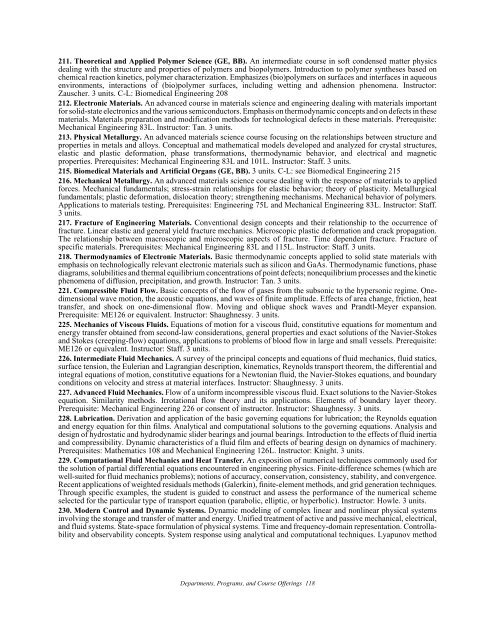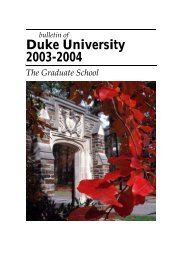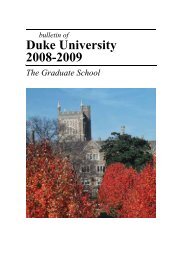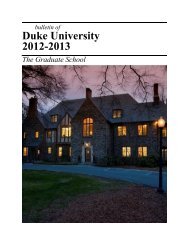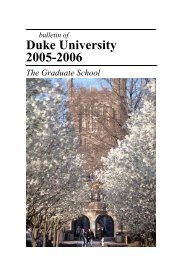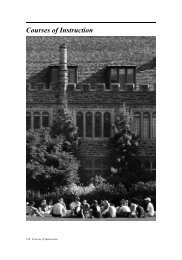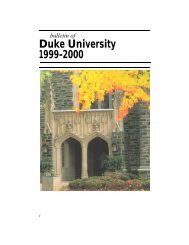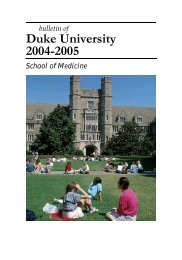Duke University 2009-2010 - Office of the Registrar - Duke University
Duke University 2009-2010 - Office of the Registrar - Duke University
Duke University 2009-2010 - Office of the Registrar - Duke University
You also want an ePaper? Increase the reach of your titles
YUMPU automatically turns print PDFs into web optimized ePapers that Google loves.
211. Theoretical and Applied Polymer Science (GE, BB). An intermediate course in s<strong>of</strong>t condensed matter physics<br />
dealing with <strong>the</strong> structure and properties <strong>of</strong> polymers and biopolymers. Introduction to polymer syn<strong>the</strong>ses based on<br />
chemical reaction kinetics, polymer characterization. Emphasizes (bio)polymers on surfaces and interfaces in aqueous<br />
environments, interactions <strong>of</strong> (bio)polymer surfaces, including wetting and adhension phenomena. Instructor:<br />
Zauscher. 3 units. C-L: Biomedical Engineering 208<br />
212. Electronic Materials. An advanced course in materials science and engineering dealing with materials important<br />
for solid-state electronics and <strong>the</strong> various semiconductors. Emphasis on <strong>the</strong>rmodynamic concepts and on defects in <strong>the</strong>se<br />
materials. Materials preparation and modification methods for technological defects in <strong>the</strong>se materials. Prerequisite:<br />
Mechanical Engineering 83L. Instructor: Tan. 3 units.<br />
213. Physical Metallurgy. An advanced materials science course focusing on <strong>the</strong> relationships between structure and<br />
properties in metals and alloys. Conceptual and ma<strong>the</strong>matical models developed and analyzed for crystal structures,<br />
elastic and plastic deformation, phase transformations, <strong>the</strong>rmodynamic behavior, and electrical and magnetic<br />
properties. Prerequisites: Mechanical Engineering 83L and 101L. Instructor: Staff. 3 units.<br />
215. Biomedical Materials and Artificial Organs (GE, BB). 3 units. C-L: see Biomedical Engineering 215<br />
216. Mechanical Metallurgy. An advanced materials science course dealing with <strong>the</strong> response <strong>of</strong> materials to applied<br />
forces. Mechanical fundamentals; stress-strain relationships for elastic behavior; <strong>the</strong>ory <strong>of</strong> plasticity. Metallurgical<br />
fundamentals; plastic deformation, dislocation <strong>the</strong>ory; streng<strong>the</strong>ning mechanisms. Mechanical behavior <strong>of</strong> polymers.<br />
Applications to materials testing. Prerequisites: Engineering 75L and Mechanical Engineering 83L. Instructor: Staff.<br />
3 units.<br />
217. Fracture <strong>of</strong> Engineering Materials. Conventional design concepts and <strong>the</strong>ir relationship to <strong>the</strong> occurrence <strong>of</strong><br />
fracture. Linear elastic and general yield fracture mechanics. Microscopic plastic deformation and crack propagation.<br />
The relationship between macroscopic and microscopic aspects <strong>of</strong> fracture. Time dependent fracture. Fracture <strong>of</strong><br />
specific materials. Prerequisites: Mechanical Engineering 83L and 115L. Instructor: Staff. 3 units.<br />
218. Thermodynamics <strong>of</strong> Electronic Materials. Basic <strong>the</strong>rmodynamic concepts applied to solid state materials with<br />
emphasis on technologically relevant electronic materials such as silicon and GaAs. Thermodynamic functions, phase<br />
diagrams, solubilities and <strong>the</strong>rmal equilibrium concentrations <strong>of</strong> point defects; nonequilibrium processes and <strong>the</strong> kinetic<br />
phenomena <strong>of</strong> diffusion, precipitation, and growth. Instructor: Tan. 3 units.<br />
221. Compressible Fluid Flow. Basic concepts <strong>of</strong> <strong>the</strong> flow <strong>of</strong> gases from <strong>the</strong> subsonic to <strong>the</strong> hypersonic regime. Onedimensional<br />
wave motion, <strong>the</strong> acoustic equations, and waves <strong>of</strong> finite amplitude. Effects <strong>of</strong> area change, friction, heat<br />
transfer, and shock on one-dimensional flow. Moving and oblique shock waves and Prandtl-Meyer expansion.<br />
Prerequisite: ME126 or equivalent. Instructor: Shaughnessy. 3 units.<br />
225. Mechanics <strong>of</strong> Viscous Fluids. Equations <strong>of</strong> motion for a viscous fluid, constitutive equations for momentum and<br />
energy transfer obtained from second-law considerations, general properties and exact solutions <strong>of</strong> <strong>the</strong> Navier-Stokes<br />
and Stokes (creeping-flow) equations, applications to problems <strong>of</strong> blood flow in large and small vessels. Prerequisite:<br />
ME126 or equivalent. Instructor: Staff. 3 units.<br />
226. Intermediate Fluid Mechanics. A survey <strong>of</strong> <strong>the</strong> principal concepts and equations <strong>of</strong> fluid mechanics, fluid statics,<br />
surface tension, <strong>the</strong> Eulerian and Lagrangian description, kinematics, Reynolds transport <strong>the</strong>orem, <strong>the</strong> differential and<br />
integral equations <strong>of</strong> motion, constitutive equations for a Newtonian fluid, <strong>the</strong> Navier-Stokes equations, and boundary<br />
conditions on velocity and stress at material interfaces. Instructor: Shaughnessy. 3 units.<br />
227. Advanced Fluid Mechanics. Flow <strong>of</strong> a uniform incompressible viscous fluid. Exact solutions to <strong>the</strong> Navier-Stokes<br />
equation. Similarity methods. Irrotational flow <strong>the</strong>ory and its applications. Elements <strong>of</strong> boundary layer <strong>the</strong>ory.<br />
Prerequisite: Mechanical Engineering 226 or consent <strong>of</strong> instructor. Instructor: Shaughnessy. 3 units.<br />
228. Lubrication. Derivation and application <strong>of</strong> <strong>the</strong> basic governing equations for lubrication; <strong>the</strong> Reynolds equation<br />
and energy equation for thin films. Analytical and computational solutions to <strong>the</strong> governing equations. Analysis and<br />
design <strong>of</strong> hydrostatic and hydrodynamic slider bearings and journal bearings. Introduction to <strong>the</strong> effects <strong>of</strong> fluid inertia<br />
and compressibility. Dynamic characteristics <strong>of</strong> a fluid film and effects <strong>of</strong> bearing design on dynamics <strong>of</strong> machinery.<br />
Prerequisites: Ma<strong>the</strong>matics 108 and Mechanical Engineering 126L. Instructor: Knight. 3 units.<br />
229. Computational Fluid Mechanics and Heat Transfer. An exposition <strong>of</strong> numerical techniques commonly used for<br />
<strong>the</strong> solution <strong>of</strong> partial differential equations encountered in engineering physics. Finite-difference schemes (which are<br />
well-suited for fluid mechanics problems); notions <strong>of</strong> accuracy, conservation, consistency, stability, and convergence.<br />
Recent applications <strong>of</strong> weighted residuals methods (Galerkin), finite-element methods, and grid generation techniques.<br />
Through specific examples, <strong>the</strong> student is guided to construct and assess <strong>the</strong> performance <strong>of</strong> <strong>the</strong> numerical scheme<br />
selected for <strong>the</strong> particular type <strong>of</strong> transport equation (parabolic, elliptic, or hyperbolic). Instructor: Howle. 3 units.<br />
230. Modern Control and Dynamic Systems. Dynamic modeling <strong>of</strong> complex linear and nonlinear physical systems<br />
involving <strong>the</strong> storage and transfer <strong>of</strong> matter and energy. Unified treatment <strong>of</strong> active and passive mechanical, electrical,<br />
and fluid systems. State-space formulation <strong>of</strong> physical systems. Time and frequency-domain representation. Controllability<br />
and observability concepts. System response using analytical and computational techniques. Lyapunov method<br />
Departments, Programs, and Course Offerings 118


